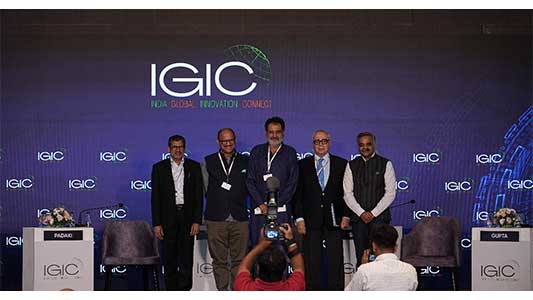Bengaluru –. Eminent leaders like Mohandas Pai, Chairman, Aarin capital, Claude Smadja, Chairman, Smadja & Smadja Strategic Advisory, Madan Padaki, President, TiE Bangalore & Trustee, TiE Global and Sanjeev Gupta, CEO, Karnataka Digital Economy Mission (KDEM) outlined a bold strategic vision for transforming India into a $7-8 trillion economy by 2030 on the last day of IGIC 2025. The dialogue brought attention to the role of digital technologies, rural economic empowerment, industrial growth and global trade integration as critical enablers.
Over 300 global leaders and industry experts convened at IGIC 2025, engaging with participants on a wide spectrum of forward-looking topics—from tapping into new funding avenues for startups and the future of defense and security, to advancing AI innovation, accelerating clean energy, and navigating the geopolitics of technology. Discussions also explored how cutting-edge AI is being leveraged by innovators, outlined a roadmap to a $7–8 trillion Indian economy by 2030, and examined strategies for fostering cross-border innovation and taking Indian innovation global.
Quotes from key industry leaders on Day 2 of India Global Innovation Connect (IGIC) 2025:
Claude Smadja, Chairman, Smadja & Smadja Strategic Advisory said, “India has the potential to become a 7-8 trillion-dollar economy, but this will require clear focus and timely execution. No country has achieved sustained growth without a strong industrial base, and India must increase its industry share while also investing more in R&D, particularly from the private sector. With a high savings rate and a strong fintech sector, India has the tools to mobilize resources for growth. The foundation is there and now it’s about acting quickly and effectively.”
“India is a very large economy; in every aspect, we’re the second or third largest. The fundamentals are strong: we’re investing, consumption is rising, services are booming, and the demographic dividend is intact. We’ve got the talent, the ambition, and the capacity to grow. Sure, there are challenges like, trade deficit, execution delays, low-paying jobs, but we’ve got wind in our sails. We’re adding the highest share to global growth, and the world is aging while we stay young. If we execute right, export more, push our companies harder, and stay the course, this country will grow. It’s a very, very exciting time to be in India” added Mohandas Pai, Chairman, Aarin Capital.
Agendra Kumar, Managing Director, Esri India said, “GIS and AI are coming together in powerful ways to support India’s vision of becoming a $7–8 trillion economy. Whether it’s bringing rural land into productive use through initiatives like SVAMITVA, enabling smarter infrastructure monitoring, or driving efficiency in agriculture and crop planning, these technologies are already creating real impact. To fully realize the potential, we must also strengthen education and update curriculums in geospatial and AI domains to meet current industry needs and improve employability. These are foundational technologies for Viksit Bharat 2047.”
Madan Padaki, President, TiE Bangalore & Trustee, TiE Global made a compelling pitch for granting full autonomy to India’s top 200 universities. “Freedom to design courses, innovate in pedagogy, and manage their own evolution is crucial,” he said, arguing that regulatory bodies like UGC and AICTE should act as guiding bodies, not gatekeepers. He also dded, that the true spirit of the National Education Policy (NEP) must be implemented—not just in letter, but in purpose.”
The IGIC 2025 event concluded with a shared vision: India’s economic ascent must be rooted in autonomy, inclusive growth, urban empowerment and global strategic engagement. A clear message emerged—India’s next leap must come from within and reaffirmed IGIC’s growing importance as a catalyst for shaping India’s innovation landscape, strengthening international collaboration, and positioning Indian startups, policy frameworks, and tech ecosystems for global impact.












